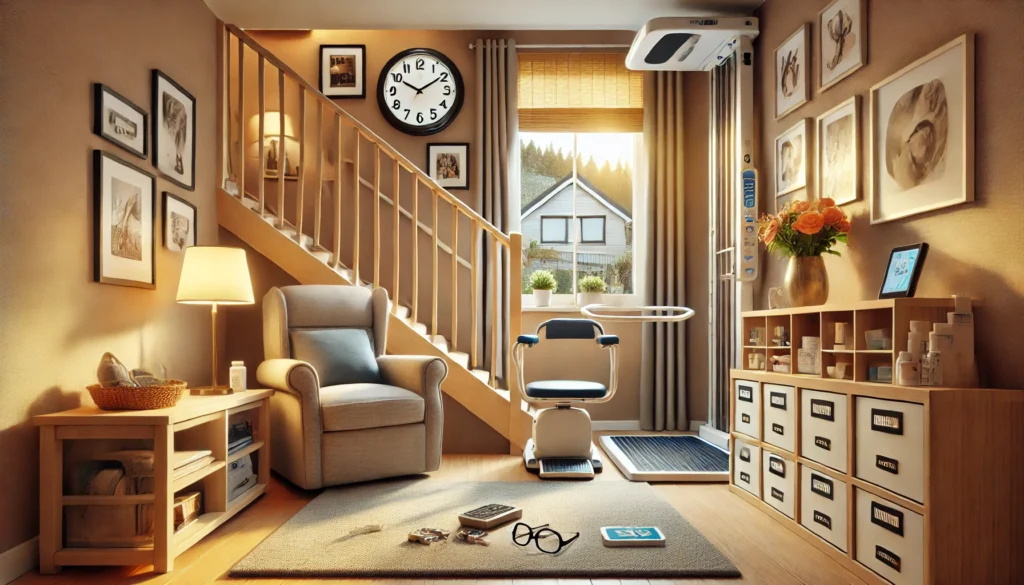As our loved ones age, ensuring their safety at home becomes a paramount concern. The thought of them being vulnerable or at risk can be heart-wrenching. However, with some thoughtful adjustments and preventative measures, you can create a safe and comfortable environment where they can thrive. Let’s explore some essential steps to ensure the safety for elderly parents at home.

1. Conduct a Home Safety Assessment
Start by walking through the home with a critical eye. Look for potential hazards that might pose a risk to an elderly person. Pay attention to areas where falls are most likely to occur, such as stairways, bathrooms, and cluttered walkways. Sometimes, the simplest changes can make the biggest difference.
2. Improve Lighting
Good lighting is crucial in preventing falls. Ensure that all areas of the home are well-lit, especially hallways, stairs, and bathrooms. Consider installing night lights in bedrooms and bathrooms to help your loved one navigate safely during the night.
3. Remove Tripping Hazards
Clutter, loose rugs, and electrical cords can all be tripping hazards. Keep pathways clear and secure any loose items. Consider removing rugs altogether or using non-slip mats to keep them in place.
4. Install Grab Bars and Handrails to Ensure Safety for Elderly Parents
Bathrooms and stairways are common places for falls. Install grab bars in the bathroom near the toilet and in the shower or bathtub. Ensure that all stairs have sturdy handrails. These additions can provide much-needed support and stability.
5. Ensure Safety for Elderly Parents: Make the Bathroom Safe
The bathroom is one of the most dangerous rooms for elderly people. Consider installing a walk-in shower or tub, and use non-slip mats in and around the shower area. A raised toilet seat and a shower chair can also be beneficial.
6. Ensure Easy Access to Frequently Used Items
Place commonly used items within easy reach to avoid unnecessary bending or stretching. This includes kitchen utensils, medications, and personal care items. Organize cupboards and shelves so that everything is easily accessible.
7. Keep Emergency Numbers Handy to Ensure Safety for Elderly Parents
Ensure that emergency contact numbers are easily accessible. Place a list of important phone numbers, including family members, doctors, and emergency services, near the phone. Consider programming these numbers into the phone for quick access.
8. Use Technology for Added Safety
Modern technology can offer additional safety measures. Consider investing in a medical alert system that allows your loved one to call for help with the push of a button. Smart home devices, like motion sensors and security cameras, can also provide peace of mind.
9. Encourage Regular Exercise
Regular physical activity can improve strength, balance, and coordination, reducing the risk of falls. Encourage your loved one to engage in safe exercises, such as walking, stretching, or light strength training, after consulting with their doctor.
10. Monitor Medications
Medications can sometimes cause dizziness or drowsiness, increasing the risk of falls. Keep a close eye on your loved one’s medication regimen and watch for any side effects. Organize medications in a pillbox to ensure they are taken correctly.
11. Fire Safety Precautions to Ensure Safety for Elderly Parents
Ensure that smoke detectors and carbon monoxide detectors are installed and functioning properly. Create an emergency exit plan and discuss it with your loved one. Keep a fire extinguisher accessible and know how to use it.
12. Check for Potential Hazards Outside the Home
Safety isn’t just about the inside of the home. Inspect the exterior as well. Ensure walkways are clear and in good repair, and that there are no tripping hazards like uneven pavement or overgrown plants. In winter, keep paths clear of snow and ice.
13. Regular Health Check-ups
Regular health check-ups are vital in ensuring that any potential issues are caught early. Encourage your loved one to keep up with doctor appointments and screenings. Maintaining good health is a crucial part of staying safe.
14. Foster Open Communication
Lastly, maintain open and honest communication with your loved one. Encourage them to share any concerns or fears they might have about their safety. Being proactive and responsive to their needs can prevent accidents and provide them with the confidence that their well-being is a top priority.
How to Ensure Safety for Elderly Parents: Conclusion
Ensuring the safety of an elderly person at home is a labor of love. It requires attention to detail, proactive measures, and a heartfelt commitment to their well-being. By making these thoughtful adjustments, you can create a safe and nurturing environment where your loved one can continue to live comfortably and securely. Remember, their safety and happiness are intertwined, and your efforts to protect them are truly an expression of your love and care.
FAQs
1. What are the most common hazards for elderly people at home? Common hazards include falls due to tripping on loose rugs, poor lighting, slippery bathroom floors, and cluttered walkways. Medications that cause dizziness and unsecured furniture are also significant risks.
2. How can technology help ensure the safety of an elderly person? Technology can provide added safety through medical alert systems, smart home devices, motion sensors, and security cameras. These tools offer quick access to help and monitoring capabilities.
3. What should be included in a home safety assessment for an elderly person? A home safety assessment should include checking for adequate lighting, removing tripping hazards, installing grab bars and handrails, ensuring bathroom safety, and making frequently used items easily accessible.
4. How can exercise contribute to the safety of an elderly person? Regular exercise improves strength, balance, and coordination, which can significantly reduce the risk of falls. Safe exercises like walking, stretching, and light strength training are beneficial.
5. Why is open communication important in ensuring the safety of an elderly person? Open communication allows elderly individuals to express their concerns and fears, enabling caregivers to address potential issues promptly. It fosters a sense of security and trust, ensuring that their needs are met effectively.